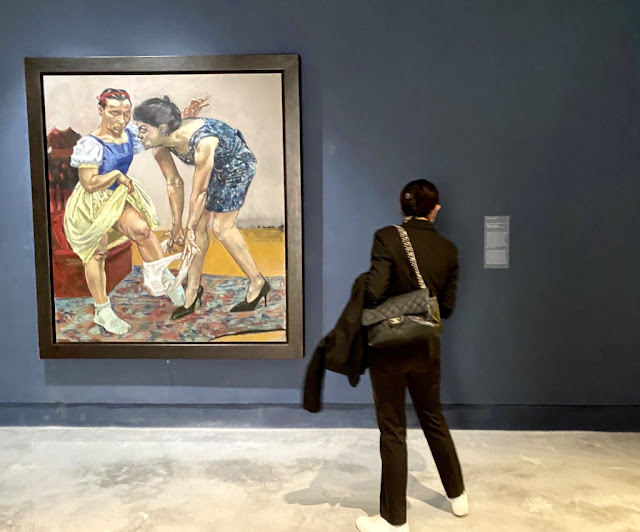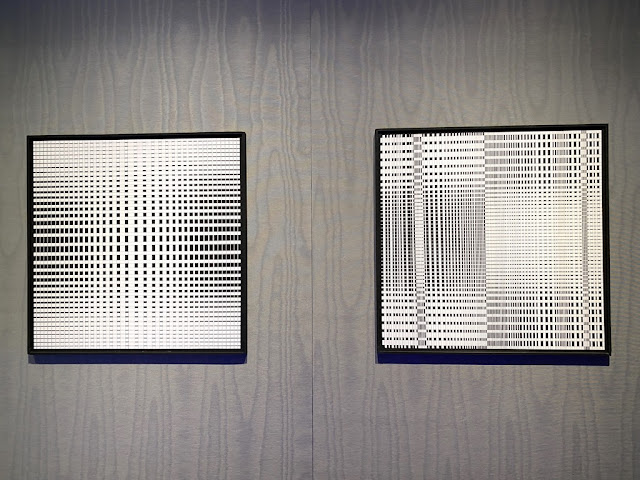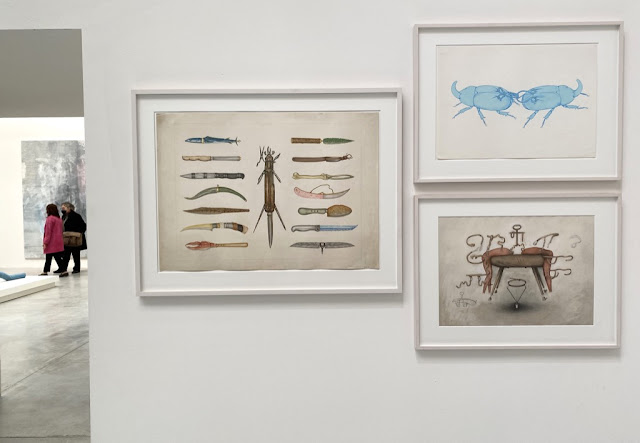La Biennale di Venezia - 59th International Art Exhibition
Padiglione Centrale - Giardini
The Milk of Dreams - Second Part
In the Padiglione Centrale of the giardini - Second Part - 59th International Art Exhibition - La Biennale di Venezia - The Milk of Dreams - curated - Cecilia Alemani - until November 27.
At twenty-six Ulla Wiggen explored the possibilities of the fusion of art and science – she
showed a series of acrylic and gouache paintings on wood panels
portraying the interior circuity of electronic devices. In her later work, her interest in the circuitry of brains and eyes supplants that of man-made machines. In her Iris Paintings - 2016–ongoing - above - the artist presents human irises laboriously painted in blues, greens, hazels on round panels, a process that can take several months per piece to complete. Citing the blurring of her vision due to cataracts prior to treatment, the artist has stated that she wanted to visually express this liminal state – one between clarity and ambiguity, between consciousness and sleep.
As a teenager, British artist Jade Fadojutimi developed an obsession with Japanese popular culture. Today, she often paints to soundtracks from Japanese videogames or anime. The moments of nostalgia Fadojutimi experiences while painting – which are also sparked by memories from her childhood, or even the clothes in her wardrobe – seep into the canvases through explosive gestures and a vivid use of colour. Beginning each painting with an attitude akin to shoshin, the Japanese concept of a - beginner’s mind - she allows the familiar objects that populate reality - a perceptive viewer might recognise objects like stockings and hats, patterned materials, or the faint suggestion of landscape lines - to elude recognition and assert their transcendent, metaphysical qualities.
Jana Euler’s work bounds between stylistic conceits, trafficking in grotesque, monstrous, contorted, eroticised, and frequently off-putting representations of figures, both human and not. Aping the jokey, anarchist attitude, surrealist fixations, and twinned scepticism and faith in the field of painting characterised by German artists of the post-war period, Euler marries their radical gestures with savage satires of the human condition. In the artist’s work, the body is frequently displayed in positions of cartoonish, abject carnality or discomfiting vulnerability. Euler’s exaggerated bodies also appear in the form of animals.
Paula Rego’s uncompromising figurative work forces viewers into direct confrontation with human relationships and the social, sexual, and emotional power dynamics that often define them. Using strategies of parody, theatricality, and storytelling, Rego’s formally complex and psychologically charged domestic scenes, which can be as equally tender as they are distressing, centre the experiences of women in a world shaped by conflict. Deeply affected by her early life in Portugal under the dictatorship of Prime Minister Antonio de Oliveira Salazar, she addresses the oppression and institutional violence towards women under political tyranny. In her mature work of the 1990s and 2000s, she intertwines references to Portuguese fairy tales, Disney princesses, and the biting satire of Francisco Goya and Honore Daumier with autobiographical elements. In her recent series Seven Deadly Sins - 2019 - Rego revives her interest in making cloth dolls as a form of sculpture, extending her fascination with parables to three-dimensional forms.
In the 1950s, after permanently settling in Mexico, Leonora Carrington dreamt up a series of bizarre children's stories that she initially painted on the bedroom walls of her sons Gabriel and Pablo, later gathering them into a private notebook. Leche del sueno - The Milk of Dreams - as Gabriel Weisz, the artists's son, dubbed the collection of fairy tales - conceals a universe of disturbing images that, by using a bizarrre verbal-visual language, narrates the story of mutant creatures that fill her fanciful universe including children who lose their heads, vultures trapped in gelatin and carnivorous machines. Under their childish veneer, Carrington's stories are scraps of dreams that are like a mother's milk, essential to a child's growth and development. As in the whole of Carrington's work, the tales of Leche del sueno - above - show a magical world where life is constantly re-envisioned through the prism of the imagination, and where everyone can change, be transformed, become something or someone else.
Technologies of Enchantment
Historical Capsule
The artists in this presentation bring somatic complexity to - programmed - artistic creation. Whether employing actual industrial materials and technologies - such as Laura Grisi's neon and plexiglas - Grazia Varisco's magnetic apparatuses, or Nanda Vigo's illuminated glass and mirrors - or applying computational logic to work in traditional artistic media - as in Marina Appolonio's optically dynamic reliefs, Dadamiano's hand-painted raster gradients, or the complex mathematical rules governing Lucia Di Luciano's masonite compositions - each artist included here works on the boundaries between technology and the self. Their work emphasise the optical effects of the viewer's movements, treat screens as skin like membranes between body and machine, and complicate traditional modes of viewership with the attraction of repulsion of chromatic and luminous surfaces; art is reconcieved as a technology of enchantment.
Nanda Vigo + Laura Grisi
Lucia Di Luciano
Austrian-born artist Birgit Jurgenssen produced a wide array of photographs, drawings, paintings, sculptures, and wearable garments before passing prematurely at the age of fifty-four. She offers a sharp feminist perspective in a Viennese art world dominated by both the transgressive masculinity of Vienna Actionism and the conservative mores of the Austrian bourgeoisie. Jurgenssen’s experiments blend matters of identity and being, Freudian psychoanalysis and Surrealism, while maintaining a degree of distinctively utopian political thinking. In her surreal drawings from the 1970, bodies are shown both in metaphoric and literal terms. Whether fantasy or nightmare, here, a representation of femininity is attached to something unfixed and altogether unknowable.
Elaine Cameron-Weir’s sculptures combine metal, glass, concrete, and stone with ephemeral elements such as flame, scent, and light. They can resemble surgical instruments, laboratory equipment, torture devices, instruments of fetishism, military gear, or medieval armour, mixing protection, pleasure and pain in a precarious balance. The works’ somatic effect is accentuated by elements that bear the imprint of traces of the body. Low Relief Icon (Figure 1) and Low Relief Icon (Figure 2) - 2021 - above - is made of factory conveyor belts counterweighted by metal caskets used by the US military for transporting bodily remains, each illuminated by flicker lights and resting on a metallic floor originally designed to hide electrical cables. Adorning the pewter disks on the conveyor belts is the repeated image of the crucifix, invoking the hero narrative of individual sacrifice that obscures actions of a State that treats life as disposable. Cameron-Weir’s hybrid objects evoke the merging of body, technology, and machine, formalising the porous entanglement between the human and the non-human.
Sable Elyse Smith’s Landscape works, a series of large-scale neons, are part of her ongoing and multi-faceted project about the US prison industrial complex and its insidious, endemic structures of anti-Black violence. For Smith, the psychic wound of mass incarceration is personal, too; she has been visiting her father in prison over approximately two-thirds of her life. Favouring a conceptual approach, Smith’s works in video, sculpture, photography, installation, and text defy conventional narratives of incarceration by drawing from personal stories and quotidian confrontations with the penal system. Smith’s neons like Landscape VI - 2022 - above - written in cool white letters, fully justified, and underscored by a bright orange-and-green horizon line, expand a tradition of Conceptual Art works. Landscape VI might be read as an expression of the embodied, everyday effects of institutional violence, juxtaposing the tone of an interior monologue with the ostentatious address of neon signage.
As a filmmaker, installation artist, and poet, P. Staff draws from a wide-ranging assortment of inspirations, materials, and settings, of which recent examples include Achille Mbembe’s theory of necropolitics, affect theory, the transpoetics of writers such as Che Gossett and Eva Hayward, as well as their own studies in modern dance, astrology, and end of life care. In Staff’s interdisciplinary practice, these varying threads serve to emphasise the processes by which bodies – especially those of people who are queer, trans, or disabled – are interpreted, regulated, and disciplined in a rigorously controlled society. The video installation On Venus - 2019 - above - continues Staff’s examination of the exchange between bodies, ecosystems, and institutions from a queer and trans perspective. Set above a mirrored floor flooded with radioactive yellow light, the moving images are comprised of warped footage documenting the industrial farming of commodities including urine, semen, meat, skins, and fur. The video’s second half includes a poem describing life on the planet Venus, a sibling to Earth but one described as a state of non-life or near-death, a queer state of being that is volatile and in constant metamorphosis. Staff’s work ultimately depicts states of violence that underpin the making of a human subject, inquiring what is at stake in the making of livable futures.
Working in the vibrant Cologne art world of the 1980s only led painter Charline von Heyl to more firmly believe in the importance of her chosen medium: painting. The eight works on view here – produced in collaboration with Jeffrianne Young and cellist Matt Haimovitz’s The Primavera Project, a series of musical commissions by a diverse group of composers – reference the Greek myth of Zephyrus, god of the west wind, and the nymph Chloris, whose marriage with Zephyrus grants her dominion over the spring; a story famously repurposed in the 1480s Sandro Botticelli’s painting Primavera. Reinterpreting Botticelli’s work, these paintings combine themes of girlhood, transformation, desire, and ambivalence. Rendering mask-like faces, graphic red dots, patterned stripes, and layers of cartoonish leaping rabbits and birds against smears of charcoal and flat washes of black acrylic paint, in Primavera 2020 - 2020 - above - the harmonious natural world of Botticelli’s original is fractured, its botanical splendour tempered by psychic upheaval. Engaging the medium’s tropes of beauty and subjectivity, von Heyl consistently redefines the boundaries of contemporary painting.
Christina Quarles’ paintings, drawings, and installations grapple with the limits of legibility and language in the fraught politics of bodies marked by race, gender, sexuality, and identity. Quarles’ paintings depict an excess of gestures in jarring pigments consisting of drips, lines, smears, and scrapes made with combs or dry brushes. With a background in graphic design, the artist pairs the fortuitous effects of dripping and seemingly improvisational brushstrokes with digital manipulation and laser-cut stencils. Her sinuous bodies contort, conjuring a sense of intimacy, fluidity, and the impossibility of outlining singular beings. As if pushing up against and trying to exceed the boundaries of the frame, the bodies suggest an alternative physicality defined by ambiguity.
Hannah Levy defamiliarises commonplace objects by warping or exaggerating their formal properties. Levy’s visual vocabulary includes medical equipment, gymnastic devices, safety bars, vegetables, pastries, and pearls. Her objects provoke repulsion and attraction to a humorous extreme. While her linear, metallic forms conjure associations with home or office furnishings, their skin-like sheaths confuse the separation between living and dead, animal and prosthetic. Indebted to the Surrealist fascination with the uncanny and the abject, her work takes an ambivalent view on the past century’s material culture. For The Milk of Dreams, Levy realises three new sculptures: a drooping sac - above - of slumped silicon balanced on four polished metal arthropod-like legs; a thin membrane of silicone stretched over a winged steel structure that is reminiscent of a bat’s wing or a tent; and a over-sized marble facsimile of a peach pit, a material used in craft traditions that contains surprising levels of the poison cyanide. Each takes an ambiguous position between functional furniture and object of aesthetic contemplation, giving corporeal form to the cycles of production, consumption, and disposal that underlie contemporary life.















